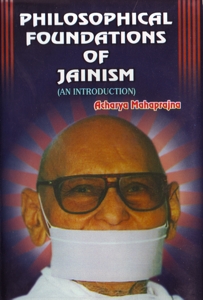The Jain philosophy is essentially a realistic philosophy. It interprets the world on the basis of five 'astikāya' (real extended existence). For explaining the concept of 'astikāya', it has adopted the logic of 'Anekānta' i.e., multifaceted approach, also known as 'Non-absolutism'. 'Syādvāda' is the style of interpretation that is used by 'Anekānta' in presenting its theory. In that sense, the end objective of both is the same, although they differ in functional approach.
'Nayavāda' (the doctrine of stand-point) is no doubt a partial view, but it does not oppose other points of views, and therefore, it serves as the foundation of 'Anekānta'. Lord Mahāvīra used the concept of two nayas (stand-points) for explaining the concept of 'astikāya' (real existence). They are 'dravyārthika naya' (substantial stand-point) i.e., describing a thing with a view-point of its underlying substance and 'paryāyārthika naya' (modal stand-point) i.e. the description of an object based on its modifications or changing modes. The 'astikāyas' are eternal i.e., without a beginning or an end. But simultaneously they are constantly evolving and taking different forms, which again are subject to change. In order to accept this duality in the attributes of 'astikāya', one needs to develop a synergie between different aspects. That is why we need to take recourse to 'anekānta', as a philosophical doctrine.
Both the 'Jain' and the 'Sāṅkhya' philosophers believe in dualism. But 'Anekānta' does not stop there. It goes further in its exploration of the synergie between the two paradoxically opposite attributes. 'Syādvāda' is, in fact, the exposition of that holistic outlook of 'Anekānta'. Hence, Jainism could be termed in one sense, as the monistic philosophy. The philosophy of Vedānta believes in the ultimate state of Brahma. On the other hand 'saṅgraha naya' i.e. the generic stand-point of 'Anekānta' would call it 'existence', (sat), without making any division between living and the non-living. It is the sum total of both living and the non-living elements. 'Anekānta' works on the principle of relativity and accepts both the opposites like Jīva and Ajīva. 'Bhūtādvaitavāda' (Materialistic Monism) and 'Caitanyādvaitavāda' (Spiritualistic Monism) both recognise only living and non-living entities respectively. But the 'saṅgraha naya', (generic stand-point) while recognizing their existence, regards their difference as peripheral and not substantive. Therefore, it would not be correct to signify the possibility of alternatives in 'Anekāntika' view, by merely counting the numbers of such alternatives. According to the Jain philosophical tradition, the basic substances are two—Jīva and Ajīva. But one can not differentiate between them in all situations. This is the key to comprehend the integral uniformity that 'Anekānta' represents. The 'Syādvāda' illustrates the above principal in following ways:
'Syāt i.e., kathancit'[1]—with respect to a certain view-point, there is difference between 'Jīva' and 'Ajīva'.
'Syāt i.e., kathancit'—with respect to another view-point, there is no difference between 'Jīva' and 'Ajīva'.
Renowned Jain philosopher Ācārya Akalanka describes the 'Jīva' as 'cetanā-cetanātmaka' i.e. having sentience and non-sentience both. It means that the soul is sentient, but Karmas which are paudgalika are non-sentient. It is 'acidātma' (non-sentient) due to its attributes like 'prameyatva' (i.e., the objectivity) and 'cidātma' (sentient) because of its 'caitanya dharma'.[2]
The term 'Syād' has often been misconstrued in the philosophical parleys. Take for instance, the comments of the renowned Buddhist Logician, Dharmakrīti, about the Jain Doctrine of Syādvāda. He has lambasted it by saying that, "the camel and the curd have their own specialities, so they would look different; how could Syādvāda treat them as similar or alike?" Among others, even Shankaracharya has branded Syādvāda as 'Saṃśayavāda' (scepticism). It seems nobody has tried to penetrate deep enough into the concept of 'syād', which denotes infinite attributes of a 'dravya' (substance). It does not mean that the Syādvāda is non-commitment to any definite view expressed, or in other words, it is shying away from taking a firm position on any issue. The expression Syād is used only for the sake of brevity in order to encompass the expanse of infinity in one single word. It is not at all symbolic of any doubt or uncertainity.
In that sense 'Anekānta' is not the negation of 'Ekānta', which is partial exposition of the existence.
Anekāntopyanekāntaḥ.
Syadrādanayasadhanaḥ..
In relative terms Syādvāda is a novel expression developed by the Jain philosophers to express the infinite attributes of 'dravya' (substance). There would always be the possibility for infinite number of alternatives and modes, that any 'dravya' can adopt. While on one hand Syādvāda tries to see 'pratiśedha' (negation) of other possibilities other than the present one in any one particular mode, on the other hand it also accepts the possibility for new alternatives which can happen in a future perspective. This has been called 'Uncertainty Principle' in modern physics by Heisenberg. Had such scientific principle been existent before the logicians like Dharmakrīti in the middle ages, they would not have mocked at the highly philosophical doctrine of Syādvāda in crude terminology.
To conclude the argument, one can say that the absolute division between Jīva and Ajīva as separate entities in all situations does not appear to be a sound proposition. If that was the case, how could they intermingle at times and fall apart in different times? So the best description would be, to acknowledge their relative compatibility and variance, together as a whole.
 Acharya Mahaprajna
Acharya Mahaprajna

